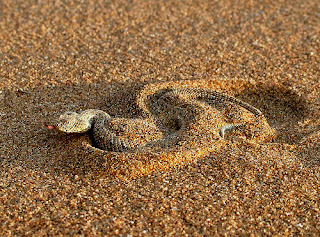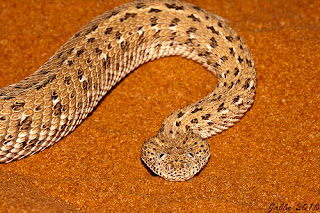Bitis peringueyi is a venomous viper species found in Namibia and southern Angola. No subspecies are currently recognized.
A small snake with an average length of 20–25 cm, its maximum recorded length was 32 cm.
The head is short and flat with eyes located on top of the head—an adaptation for hunting. It is covered with strongly keeled scales, the smallest of which are located anteriorly. The eyes are separated by six to 9 scales, while each is surrounded by 10-13 scales. Two to four scales separate the suborbitals from the supralabials. The latter number 10-14, the sublabials 10-13. The chin shields contact the first two to four sublabials.
The dorsal scales number 23-31 at midbody and 21-27 anteriorly. All are strongly keeled except for those bordering the ventral scales, which are large and smooth. The ventrals number 117-144. The 15-30 subcaudals are usually keeled, particularly towards the tip. The anal plate is single.
The color pattern consists of a pale buff, chestnut brown to orange-brown, or sandy-grayish ground color, overlaid with three longitudinal series of faint, elongate, gray to dark spots. The body is also stippled with an irregular pattern of pale and dark spots. The belly is usually whitish or dirty yellow. The tail is generally tan, but in 25% of specimens, it is black.
Common names of this snake include Peringuey's adder, Peringuey's desert adder, sidewinding adder, Namib dwarf sand adder, dwarf puff adder, Namib desert sidewinding adder, dwarf sand adder, Namib dwarf adder, and Namib desert viper.






